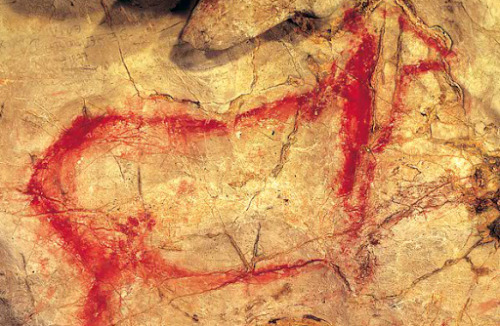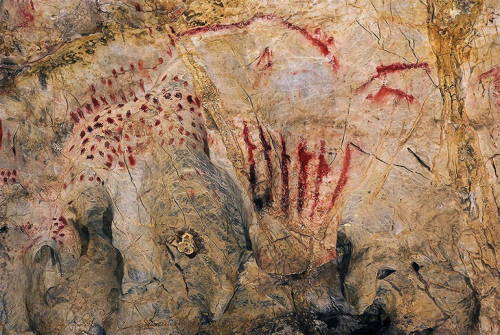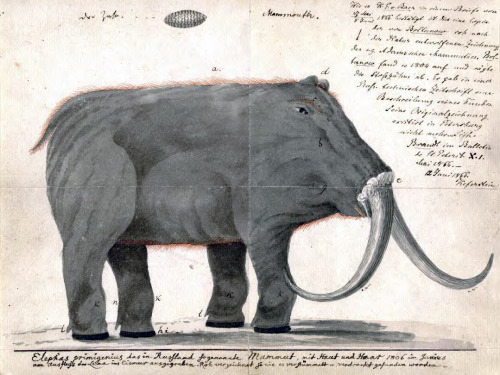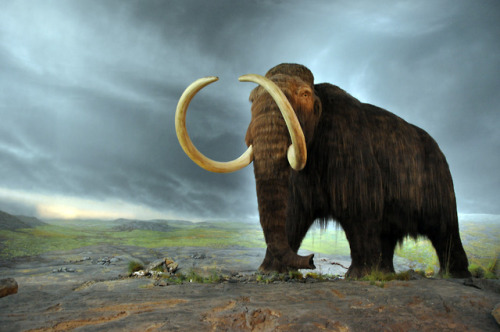#woolly mammoth

RJ Palmer just wrapped up a series of illustrations about cool, imaginative griffin designs and I felt inspired to make one of my own. Here’s a giant, terrestrial griffin trying its best to become a rough sauropod.
The Elephant In Love
The El Pindal cave is located in Asturias, Spain and contains about 20 paleolithic artworks. The paintings inside this cave are a bit older than the Rouffignac cave, they are dated back to two periods during the paleolithic: 22,000 years ago and 17,000 years ago. What makes this cave especially special is the presence of quite a unique depiction of a woolly mammoth, that is how the cave earned its Spanish nickname ‘Elefante Enamorado’, the elephant in love.
The paintings inside this cave were discovered in 1908 by a local archeologist named Hermilio Alcade del Rio. The cave itself is about 600 meters long in length, the first 300 meters is opened up for visitors. Even though the paintings were discovered in 1908, only recent research has revealed the age of the works. Unfortunately not all of the 20 cave paintings are visible to the naked eye. The El Pindal cave has deteriorated quite a bit throughout the centuries due to climate changes.
The paintings that are still visible show the images of horses, a salmon, a red deer, abstract symbols, a bison and the most notable of them all, a woolly mammoth with a shape inside of it that looks like a heart. The appearance of a mammoth painting came as quite the surprise to researchers as depictions of mammoths are very rare in modern day Spain. It is thought that early modern humans in modern day Spain viewed the wild horse as a more sacred animal than the mammoth, while in modern day France the mammoth seemed to have been the most important spiritual animal.
Of course we can not know the exact reason why there is a heart-shaped figure inside the mammoth painting. It is also unknown and doubtful if early humans used the same symbol for a heart as we do today. Even though it is tempting to believe that this mammoth was drawn by people who adored the animal, it is more likely that this is actually a depiction of a wounded woolly mammoth.
Interestingly, the cave doesn’t contain any traces of habitation so it seems that early humans have used this cave solely for religious reasons. What kind of ritual would have involved drawing a mammoth with this strange heart-shaped symbol? Was it perhaps drawn by a hunter hoping for an easy hunt? Or was our first assumption right after all and an early human drew this mammoth as a symbol of endearment? We will never know..
Here are photos of:
The cave art and entrance of the El Pindal cave.
Post link
Rediscovery Of The Woolly Mammoth
The woolly mammoth is a species of mammoth that unfortunately went extinct around 10,000 years ago, this animal is also seen as the symbol of ancient European ice ages. Small populations of woolly mammoths continued to survive on the Wrangel Island in Russia until as recent as 4,000 years ago. There were still some mammoths left when the great pyramids in Egypt were being built.
Even though all mammoth species are now extinct, their legacy continues to live on in the minds of modern humans. Their bones and tusks are still being used until this very day. The indigenous cultures of Siberia and North America still contain myths explaining the presence of mammoths and other extinct megafauna. Whether these myths are based on ancient memories of ancestors who have witnessed these animals or based on found remains throughout the centuries is not fully known.
Indigenous Siberian people believe that the remains of woolly mammoths were once part of an animal able to crawl underground, also an explanation why earthquakes happen. If a mammoth was unfortunate enough to crawl upwards and reach the surface, it would die. This is one of the legends surrounding the woolly mammoth that has survived until this day. Indigenous north American people had similar stories of mammoths living underground. Another native-American legend, of the Inupiat people, suggests that mammoths were primordial giants.
Long before the western world started to seriously study ancient extinct species, parts of mammoth remains, such as their tusks, were imported into Europe. This precious ivory is still worth an incredible amount of money but back in the medieval ages, no one thought this ivory came from an extinct species. Europeans had several explanations for woolly mammoth remains: they probably belonged to an escaped herd of elephants during the Roman republic, they were the actual war elephants of Hannibal, they are simply just elephants who wandered a bit too far north or they are the victims of the great flood described in the biblical book genesis.
The first person who recognized that these remains were actually part of an extinct species of elephant was Hans Sloane back in 1728. Sloane published a paper in that year what can now be considered as the first scientific research on the woolly mammoth. 10 years later another researcher, Johann Philipp Breyne, also researched mammoth fossils and came to the conclusion that they are a species of elephant. Both men were however clueless on how these ‘elephants’ got in Siberia and proposed the theory that they were victims of Noah’s flood.
It took until 1796 when these mysterious 'elephant’ remains from Siberia were finally identified as a completely different species, not modern elephants as thought before but an entirely new species. French anatomist Georges Cuvier was the first to identify the woolly mammoth as a mammoth species and the German naturalist Johann Friedrich Blumenbach gave the species its official scientific name 'Mammuthus Primigenius’.
In 1806, a Russian botanist Mikhail Adams journeyed towards northeastern Siberia to witness the most complete woolly mammoth skeleton found back in 1799. (the most complete of that time period, more complete and intact mammoth remains have been found since 1799) It was the first time that the entire skeleton, without the tusks, was found. The remains were brought back to St Petersburg and an attempt was made to reassemble the skeleton. There was however one problem, no one knew how the tusks would have looked like so the tusks were mounted on the wrong sides so that the curves went outwards instead of inwards. This mistake wasn’t corrected until 1899 and is still visible in the famous sketch of Adams mammoth.
Nowadays multiple subspecies of mammoth have been discovered, the woolly mammoth is just one of the mammoth species that once roamed the earth. It took until 2005 before researchers were finally able to complete a full mitochondrial genome profile of the woolly mammoth. 10 years later in 2015 it was confirmed that the closest living relative of the woolly mammoth is the asian elephant. If an attempt is ever made to bring back the woolly mammoth, our modern asian elephants can help us out. But the subject of bringing the woolly mammoth back to life again is a topic for another post.
Here are images of:
Woolly mammoth by Mihin89,
The Adams mammoth right now, with the tusks in the correct position,
Sketch of Adams mammoth with the tusks on the wrong side,
Post link
A woolly mammoth statue carved from woolly mammoth ivory 35,000 years ago, found in Germany.
Post link
“Church’s woolly mammoth research is just one of several de-extinction projects—there are about ten underway now—that aim to use genetics to restore lost species. In her book “The Re-Origin of Species,” the Swedish science journalist Torill Kornfeldt travels the world meeting the scientists and conservationists involved in this movement. In California, she talks with Ben Novak, a scientist obsessed with bringing back the passenger pigeon—a bird that once travelled in flocks that were so giant and dense, Novak tells her, that they “swept through the landscape, with the same effect as forest fires.” In upstate New York, a researcher is working toward restoring the American chestnut, which was decimated by blight in the late eighteen-hundreds. Until then, chestnuts were so prevalent in the eastern half of the United States that, when their white blossoms fell in the spring, the hillsides looked like they were covered in snow; in the fall, their sweet, starchy nuts served as a free, abundant harvest. At Australia’s Sea Simulator aquarium, resurrection scientists are working on coral, which faces an existential threat from the rapid warming and acidifying of ocean waters.
Read the full story: The New Yorker: The Woolly Mammoth Lumbers Back Into View
(Image Credit: Wikimedia Commons)
Post link











